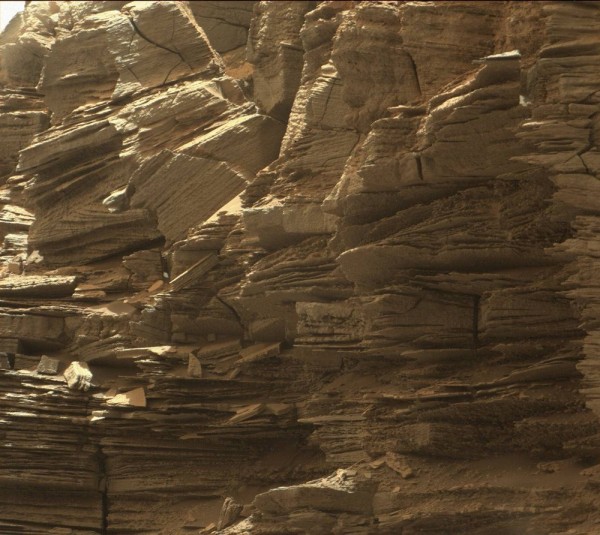By Ana Verayo, | September 12, 2016

This closeup view from NASA's Curiosity rover shows finely layered rocks, deposited by wind long ago as migrating sand dunes
NASA's Mars Curiosity rover just sent back new images of the Red Planet's incredible rock formations. Layers of rock that can be seen throughout the terrain is located in a region known as Murray Buttes.
These images released by NASA's Jet Propulsion Laboratory were taken by Curiosity's onboard camera, the MASTCAM on September 8. These remarkable rock formations that are seen in the region are composed of ancient layers of sandstone that went through erosion over thousands of years, due to the formation of Mount Sharp.
Like Us on Facebook
According to project scientist Ashwin Vasavada of NASA's JPL in Pasadena, California, the entire team is thrilled about this discovery where they will now create a new mosaic from imagery taken by the rover over the southwestern desert region of Mars.
For this leg of the mission, this layered rock formation will be the last stop of Curiosity along the Murray Buttes region. The rover will now continue its journey towards the southern region of Mars also exploring the highest parts of Mount Sharp.
Vasavada adds, by studying these formations up close, these have provided a better understanding of ancient sand dunes that were buried then transformed by groundwater via chemical processes. After that, these land formations were exhumed and eroded that resulted in this landscape today.
Scientists have made breakthrough discoveries on Mars via rover and probes currently orbiting and exploring the arid, dusty planet today. However, there is an increasing concern over man made pollution on planetary missions like this, that could contaminate the exoplanet's water resources and what's left of it, via microbes from Earth that are carried by these rovers.
According to NASA's Office of Planetary Protection's Catharine Conley, this can become a big problem on waterways on Mars where the effects of pollution are still unknown to microbial life. Mars is highly likely to support life unlike comets and asteroids where man made pollution can disturb its delicate ecosystem.
NASA plans to send humans to Mars by the 2030s to establish the first human colony on the planet however, NASA planetary protection engineer James Bernardini says that it is fundamental to evaluate and conduct more research in the introduction of a new organism on a new planet. This is also about humans being good stewards in the universe we live in, he adds.
-
Use of Coronavirus Pandemic Drones Raises Privacy Concerns: Drones Spread Fear, Local Officials Say

-
Coronavirus Hampers The Delivery Of Lockheed Martin F-35 Stealth Fighters For 2020

-
Instagram Speeds Up Plans to Add Account Memorialization Feature Due to COVID-19 Deaths

-
NASA: Perseverance Plans to Bring 'Mars Rock' to Earth in 2031

-
600 Dead And 3,000 In The Hospital as Iranians Believed Drinking High-Concentrations of Alcohol Can Cure The Coronavirus

-
600 Dead And 3,000 In The Hospital as Iranians Believed Drinking High-Concentrations of Alcohol Can Cure The Coronavirus

-
COVID-19: Doctors, Nurses Use Virtual Reality to Learn New Skills in Treating Coronavirus Patients







